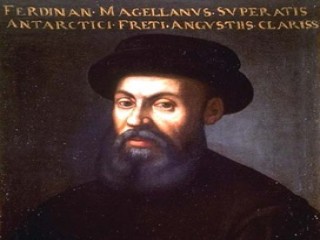
Ferdinand Magellan biography
Date of birth : -
Date of death : 1521-04-27
Birthplace : Sabrosa, Portugal
Nationality : Portuguese
Category : Arhitecture and Engineering
Last modified : 2011-05-02
Credited as : Explorer, voyage of discovery to circumnavigate the globe, Magellanic Penguin
While in the service of Spain, the Portuguese explorer Ferdinand Magellan (1480-1521) led the first European voyage of discovery to circumnavigate the globe.
Ferdinand Magellan was born in Oporto of noble parentage. Having served as a page to the Queen, Magellan entered the Portuguese service in the East in 1505. He went to East Africa and later was at the battle of Diu, in which the Portuguese destroyed Egyptian naval hegemony in the Arabian Sea. He went twice to Malacca, the Malayan spice port, participating in its conquest by the Portuguese. He may also have gone on an exploratory mission to the Molucca Islands (Spice Islands), the original source of some of the most valuable spices.
In 1513 Magellan was wounded in one of the many frustrating battles against the Moors in North Africa. But all of his services brought him little favor from the Crown, and in 1517, accompanied by his friend the cosmographer Ruy Faleiro, he went to Seville, where he offered his services to the Spanish court.
The famous Treaty of Tordesillas (1494) had divided the overseas world of the "discoveries" between the two powers. Portugal acquired everything from Brazil eastward to the East Indies; the Spanish hemisphere of discovery and conquest ran westward from Brazil to 134°E meridian. This eastern area had not yet been explored by the Spaniards, and they assumed that some of the Spice Islands might lie within their half of the globe. They were wrong, but Magellan's scheme was to test that assumption.
In addition it must be recalled that Columbus had made a terrible mistake, brought home by his "discovery" of America. Accepting the academic errors of learned geographers, ancient and modern, he had grossly underestimated the distance between Europe and the East (sailing westward from the former). Balboa's march across the Panamanian Isthmus had subsequently revealed the existence of a "South Sea" (the Pacific) on the other side of Columbus's "mainlands in the Ocean Sea." Thereafter, explorers eagerly sought northern and southern all-water passages across the stumbling block of the Americas; Magellan, too, sought such a passage.
King Charles V of Spain (the emperor Charles V) endorsed the design of Magellan and Faleiro, and on Sept. 20, 1519, after a year's preparation, Magellan led a fleet of five ships out into the Atlantic. Unfortunately the ships—the San Antonio, Trinidad, Concepcion, Victoria, and Santiago—were barely seaworthy, and the crews, including some officers, were of international composition and of dubious loyalty to their leader. With Magellan went his brother-in-law, Duarte Barbosa, and the loyal and able commander of the Santiago, Jono Serrno. Arriving at Brazil, the fleet sailed down the South American coast to the Patagonian bay of San Julian, where it wintered from March to August 1520. There an attempted mutiny was squelched, with only the top leaders being punished. Thereafter, however, the Santiago was wrecked, and its crew had to be taken aboard the other vessels.
Leaving San Julian, the fleet sailed southward; on Oct. 21, 1520, it entered the Strait of Magellan. It proceeded cautiously, taking over a month to pass through the strait. During this time the master of the San Antonio deserted and sailed back to Spain, and so only three of the original five ships entered the Pacific on November 28. There followed a long, monotonous voyage northward through the Pacific, and it was only on March 6, 1521, that the fleet finally anchored at Guam.
Magellan then passed eastward to Cebu in the Philippines, where, in an effort to gain the favor of a local ruler, he became embroiled in a local war and was slain in battle on April 27, 1521; Barbosa and Serrno were killed shortly thereafter. With the crew wasted from sickness, the survivors were forced to destroy the Concepcion, and the great circumnavigation was completed by a courageous former mutineer, the Basque Juan Sebastian del Cano. Commanding the Victoria, he picked up a small cargo of spices in the Moluccas, crossed the Indian Ocean, and traveled around the Cape of Good Hope from the east. With a greatly reduced crew he finally reached Seville on Sept. 8, 1522. In the meantime the Trinidad, considered unfit to make the long voyage home, had tried to beat its way against contrary winds back across the Pacific to Panama. The voyage revealed the vast extent of the northern Pacific, but the attempt failed, and the Trinidad was forced back to the Moluccas. There its crew was jailed by the Portuguese, and only four men returned after 3 years to Spain.
Magellan's project brought little in the way of material benefit to Spain. The Portuguese were well entrenched in the East, their trans-African route at that time proving to be the only feasible maritime connection to India and the Spice Islands. Charles V acknowledged the political and economic facts by selling his vague East Indian rights to Portugal, rights that were later in part resumed with the Spanish colonization of the Philippines. Yet though nearly destroying itself in the process, the Magellan fleet for the first time revealed in a practical fashion the full extent of humanity's inheritance upon this globe. And in this, its scientific aspect, it proved to be the greatest of all the "conquests" undertaken by the gold-, slave-, and spice-seeking overseas adventurers of early modern Europe.
















